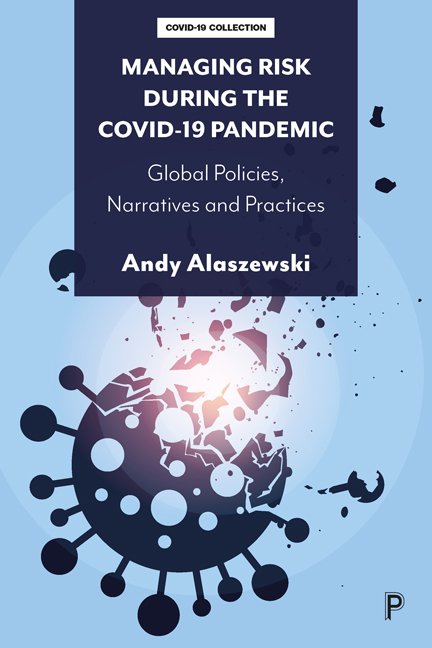Book contents
- Frontmatter
- Dedication
- Contents
- List of tables
- List of abbreviations
- About the author
- Acknowledgements
- Foreword
- Preface
- 1 Introduction: risk as a key feature of late modern societies
- PART I Responding to the challenges of the pandemic
- PART II Mitigating risk through science and technology
- PART III Risk narratives
- References
- Index
2 - Managing uncertainty: framing COVID-19
Published online by Cambridge University Press: 20 January 2024
- Frontmatter
- Dedication
- Contents
- List of tables
- List of abbreviations
- About the author
- Acknowledgements
- Foreword
- Preface
- 1 Introduction: risk as a key feature of late modern societies
- PART I Responding to the challenges of the pandemic
- PART II Mitigating risk through science and technology
- PART III Risk narratives
- References
- Index
Summary
Responding to the developing challenges of a new infectious disease
Risk and framing
In early 2020, COVID-19 was a new disease, so there was no evidence on which to base an assessment of risk. One way of dealing with this uncertainty was to equate the new disease with an existing disease, a process that can be referred to as framing. Goffman (1975) argues that when faced with a puzzling or novel situation, individuals have to decide ‘What is going on here?’, and framing enables them to do this. When framing a new phenomenon, individuals and groups draw on their knowledge of similar events or situations. A significant event that attracted substantial public and media attention can become a reference point and a frame for similar events in the future. If the original event is linked to a name or phrase, then this is used when framing subsequent events. For example, since President Nixon's resignation in 1974 following the burglary of the Democratic National Committee headquarters in Watergate Office Building, the suffix ‘gate’ has referred to alleged illegal events that have been covered up, such as Partygate, the breaches of COVID-19 lockdown rules at the UK prime minister's residence (O’Grady, 2022). Aronowitz (2008) notes that framing a disease is a way of recognising, defining, naming and categorising it, and attributing it to a cause or set of causes. Such framing shapes individual and collective responses (2008, p. 2).
The development and maintenance of frames
Framing is influenced by the interests of individuals and groups. For example, when the aircraft manufacturer Boeing launched a new aircraft, the 737 Max, it was in its interest to frame it as a minor modification of the 737 rather than a new design, as this reduced the costs of regulatory approval. This framing was accepted both by the regulatory authority, minimising scrutiny, and by the airlines, minimising pilot retraining. As a congressional inquiry made clear, the new plane was actually significantly different and had a basic design flaw ‘that resulted in the tragic and preventable deaths of 346 people’ (The House Committee on Transportation and Infrastructure, 2020, p. 5).
- Type
- Chapter
- Information
- Managing Risk during the COVID-19 PandemicGlobal Policies, Narratives and Practices, pp. 11 - 27Publisher: Bristol University PressPrint publication year: 2023



